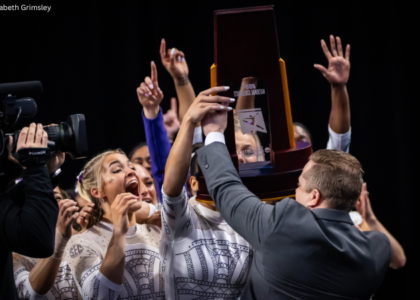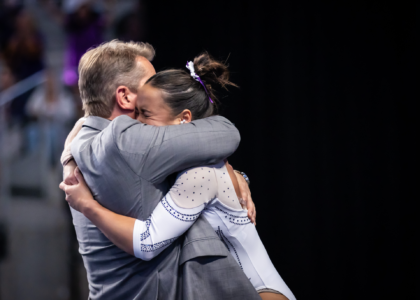The 2016 season saw the world of collegiate vault—and its recruiting—turned on its head with the Yurchenko full being devalued from a 10.000 start value to a 9.950. It then took until 2019 for the league to see a vault lineup start from a maxed out 50.000 with Oklahoma, who would go on to be national champion that season. Nationally, lowering the start value for the most frequently seen vault became the new example of how to weigh execution against difficulty. Each team began to face this age-old question of gymnastics philosophy, and schools with stellar recruiting power were able to bring in athletes specifically to have it both ways: clean and reliable 10.0 start values.
Across the midwest, the answer is rarely that simple. Coveted Yurchenko one and a halves and double twists are seldom recruited into the MAC, with standout vaulters post-pandemic shutdown having raised their recruiting “market value” with dynamic front handspring, Tsuk, or twisting Yurchenko entries.
Immediately after the change came into play, Northern Illinois’ head coach Sam Morreale noticed its effects recruiting out of the level 10 program. The Huskies had in his words “created a staple of eight to 10 fulls, and then they devalued them… The good thing is it happened to everybody, and as a mid-major [conference], all of us are kind of in the same boat.” Level 10 coaches began teaching their athletes different vault entries instead of chasing the extra half twist and in Morreale’s words “becoming more alive again.” For an athlete with a front entry vault to be offered a scholarship before the start value change, it had better have been stellar.
The same sentiment was echoed by Western Michigan’s head coach Penny Jernigan. Her team’s priority when recruiting is all-arounders, and then gymnasts who can contribute three events. Enter sophomore Cassie St. Clair, who was recruited for three events but would quickly make a name for herself on leg events as a forwards gymnast. Blind landings come naturally to her, and less than two seasons in she’s made a name for herself competing the NCAA’s only tucked Tsukahara one and a half. St. Clair candidly states Yurchenkos are not for her and that she’s the “odd man out of the group.” Jernigan sees her vault through a different lens, calling her a unicorn and eagerly waiting for her to “nail it at the right time” to advance deep into the postseason.
On the flip side of the vaulting coin, select MAC gymnasts will train upgraded vaults outside of competition-geared training assignments. The natural progression for athletes coming to university with a Yurchenko full is to add a half twist, but not all training facilities are created equal—that directly affects how gymnasts prioritize upgrades, and for how long those upgrades remain in the lineup.
Kent State assistant coach Craig Ballard notes his team’s pit-less vault setup is directly correlated to the 10.000 start values it’s able to compete. Competition regulation landing is available, but the Golden Flashes often vault instead to a ground level resi. While they don’t typically experience issues translating vaulting there to vaulting on meet day, the lack of a loose foam pit isn’t ideal for training, or maintaining, harder vaults. They’re fortunate to train vaults into a pit off campus, but with scheduling conflicts, Ballard adds “you can’t do that every day.” The team’s gym is set to be renovated this summer, and he believes it’ll be a big chance to upgrade Yurchenko fulls. The pit will also allow gymnasts to maintain harder vaults they trained in club while minimizing landing pressure.
Morreale’s Huskies have the opposite problem, with mats over a resi being their main vault landing surface in their training gym. He often aims to ease his vault lineups into season over the initial few weeks, going for controlled vaults with a step back rather than stuck ones. Deciding when to upgrade is an art form of his, pulling from a given athlete’s similar skills on other events and their air awareness.
Lineup transparency is an integral part of the Huskies’ strategy, from recruiting trips lead by Morreale right through to meet day. For the team to have confidence in itself, the gymnasts know that the top six that day make a lineup, not the historically strongest six on the roster. Similarly, Jernigan typically considers the top eight vaulters to be absolutely necessary. This year her team’s vault depth extends down to 11 athletes, with upperclassmen making up all but one of those spots. The Broncos’ depth is key to lasting all season, allowing them to swap gymnasts in and out as some may deal with injury, illness or even fatigue. Ballard comparably fills his vault lineup with upperclassmen, allowing freshmen more time to adjust to the collegiate environment. Any way the coaches put it, the way to lead the MAC on vault is depth.
How do coaches pick lineups for the event with a near-compulsory skill and with such deep teams? Ballard turns to his favorite movie, “Moneyball,” for the answers. His favorite scene includes a discussion about how Billy Beane doesn’t care how a player gets on base, just that he does. Ballard likens the vault lineup to that interaction, examining the odds of his gymnasts hitting 9.850. If that score is within reach week in and week out, it doesn’t matter to him if it comes from a 9.950 start value.
Jernigan touched on a coincidence this year from the Bronco’s vault squad: There’s no correlation between her vault lineup and slotting athletes for the all-around. Western Michigan is one of the more all-around heavy teams in the MAC, but purely because those athletes are at the top of all four depth charts. Simply, “if they happen to be an all-arounder, they happen to be an all-arounder, but the top six vaulters that day are the six that are going to go.”
At the end of the day, vault is one of four puzzle pieces factoring into post-season qualification, and it’s at the forefront of every MAC coach’s mind regardless of outside media attention. To Morreale, it may be easier to qualify an all-arounder to regionals, but if they’re not truly in the top six on vault, then the entire team takes a hit in scoring. His aspirations are to get a full team qualified, and that takes priority. However, 10 potential points to be earned on vault are worth the same as 10 potential points on floor—making the event just as high stakes and an equally important battleground for each gymnast to fight for every tenth possible.
READ THIS NEXT: For Michigan, Success on Vault Lies in the Details
Article by Peri Goodman
Like what you see? Consider donating to support our efforts throughout the year!





5 comments